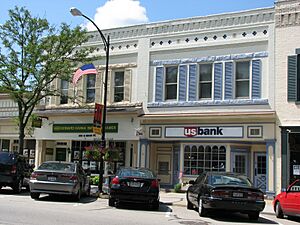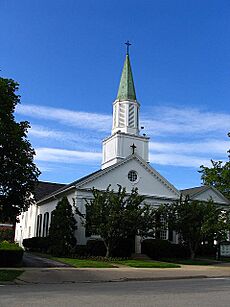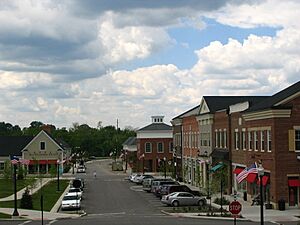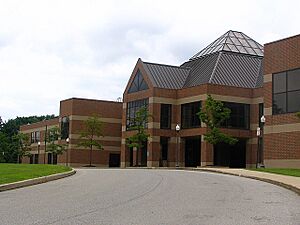Hudson, Ohio facts for kids
Quick facts for kids
Hudson, Ohio
|
|
|---|---|
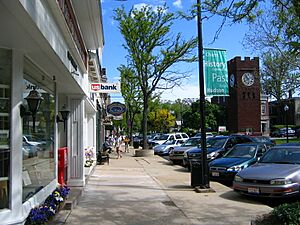
North Main Street, Hudson Historic District
|
|
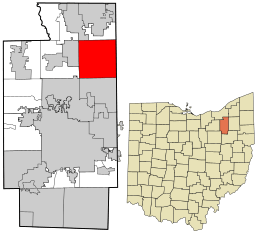
Location in Summit County and the state of Ohio.
|
|
| Country | United States |
| State | Ohio |
| County | Summit |
| Settled | 1799 |
| Incorporated | 1837 |
| Village/Township Merger | 1994 |
| Founded by | David Hudson |
| Named for | David Hudson |
| Government | |
| • Type | Council-Manager |
| Area | |
| • Total | 25.88 sq mi (67.04 km2) |
| • Land | 25.63 sq mi (66.37 km2) |
| • Water | 0.26 sq mi (0.67 km2) |
| Elevation | 1,066 ft (325 m) |
| Population
(2020)
|
|
| • Total | 23,110 |
| • Density | 901.85/sq mi (348.21/km2) |
| Demonym(s) | Hudsonite |
| Time zone | UTC-5 (EST) |
| • Summer (DST) | UTC-4 (EDT) |
| ZIP code |
44236
|
| Area code(s) | 330, 234 |
| FIPS code | 39-36651 |
| GNIS feature ID | 2394437 |
Hudson is a city in northern Summit County, Ohio, United States. About 23,110 people lived there in 2020. It's a suburban area near the city of Akron.
A famous person named John Brown made his first public promise to fight slavery in Hudson. The city later became an important part of the Underground Railroad. This was a secret network that helped enslaved people find freedom. The Village of Hudson and Hudson Township used to be separate. They joined together in 1994 to form the city we know today.
Contents
History of Hudson, Ohio
The city is named after its founder, David Hudson. He moved there from Goshen, Connecticut, in 1799. At that time, it was part of the Connecticut Western Reserve. The village of Hudson was officially formed in 1837.
David Hudson built the very first log house in Summit County, Ohio. You can find a marker for it at the corner of Baldwin Street and North Main Street.
Early Education and Famous Schools
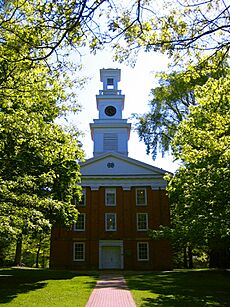
Hudson had a strong New England feel because of its early settlers. It became home to Western Reserve College and Preparatory School. This school was started in 1826 by David Hudson and others. People even called it the "Yale of the West."
The college later moved to Cleveland in 1882. It eventually became part of Case Western Reserve University. The old red brick buildings, inspired by Yale, are now home to the Western Reserve Academy. The Loomis Observatory was built in 1838. It's the oldest observatory in the U.S. that is still in its original spot.
Railroads and Important Visitors
The Cleveland and Pittsburgh Railroad started service to Hudson in 1852. In 1861, President-elect Abraham Lincoln visited Hudson. He spoke to about 6,000 people from his train car. This happened at the old Hudson Depot. Passenger train service in Hudson ended in 1965.
Rebuilding and Industry
A big fire happened on Main Street in Hudson in 1892. It destroyed many buildings. Another fire in 1903 caused more damage. James Ellsworth, who was born in Hudson, helped rebuild Main Street. He also helped the Western Reserve Academy reopen after it had closed.
In 1882, Gustave H. Grimm started a company in Hudson. It made equipment for producing maple syrup. This area is now called "The Evaporator Works."
The Hudson Clock Tower
The Hudson Clock Tower was built in 1912. It was a gift from James Ellsworth. The clock used heavy weights to power its movement and chimes. The town marshal used to wind the clock every few days.
James Ellsworth's son was Lincoln Ellsworth. Lincoln Ellsworth was a famous polar explorer. He is the only person from Hudson to be featured on a U.S. postage stamp. The Ellsworth Mountains are named after him.
Modern Industry and Growth
From 1957 to the late 1980s, General Motors had a large factory in Hudson. It built earth-moving equipment and employed almost a thousand workers. Today, Jo-Ann Stores uses most of this former factory. Hudson also had an airport from the mid-1920s until 1957.
In 1994, the City of Hudson was formed. This happened when voters decided to combine Hudson Township and Hudson Village. These had been two separate governing areas before.
In July 2003, Hudson experienced very heavy rainfall. Over 17 inches of rain fell in 24 hours. This caused flooding in many areas of the city.
Morse Controls Company
John F. Morse, Jr. started the Morse Instrument Company in Hudson. It was later called Morse Controls. This company made devices for airplanes, cars, and boats. By 1969, it had over 600 employees. The plant closed in 2020.
Hudson's Role in Fighting Slavery
Ohio's Western Reserve was a very strong anti-slavery area. Hudson, with its first college, was an important center for new ideas. Many of Hudson's founders were against slavery. Owen Brown, the father of John Brown, was a passionate abolitionist. John Brown, who grew up in Hudson, became a key figure in the fight against slavery.
A historical marker shows where the First Congregational Church held its first meeting. In 1835, church members declared that slavery was "a direct violation of the law of Almighty God." In 1837, John Brown made his first public promise to end slavery at a prayer meeting there.
Thousands of fugitive slaves passed through Hudson on their way to freedom in Canada. Hudson was a stop on the Underground Railroad. Owen Brown helped many of these people. Many places in Hudson are connected to the Underground Railroad.
Hudson's strong anti-slavery leadership changed in the early 1830s. A professor named Beriah Green spoke out strongly against slavery. This caused a lot of discussion and disagreement in the town and college. Green later left to lead another school, the Oneida Institute, which welcomed Black students. Oneida then became a leading center for the abolitionist movement.
Geography of Hudson
Hudson is located in northeastern Summit County. The city covers about 25.87 square miles (67.04 square kilometers). Most of this area is land, with a small amount of water.
Neighboring Communities
Hudson shares borders with several other towns and townships. These include Macedonia, Twinsburg Township, Aurora, and Streetsboro. To the south, it borders Stow.
Waterways and Creeks
Water in Hudson flows into five main areas called watersheds. The three most important ones are Brandywine Creek, Mud Brook, and Tinkers Creek. Small parts of Hudson also drain into the Cuyahoga River and Fish Creek.
Population and People
| Historical population | |||
|---|---|---|---|
| Census | Pop. | %± | |
| 1870 | 868 | — | |
| 1890 | 1,143 | — | |
| 1900 | 933 | −18.4% | |
| 1910 | 1,031 | 10.5% | |
| 1920 | 1,134 | 10.0% | |
| 1930 | 1,324 | 16.8% | |
| 1940 | 1,417 | 7.0% | |
| 1950 | 1,538 | 8.5% | |
| 1960 | 2,438 | 58.5% | |
| 1970 | 3,933 | 61.3% | |
| 1980 | 4,612 | 17.3% | |
| 1990 | 5,159 | 11.9% | |
| 2000 | 22,439 | 334.9% | |
| 2010 | 22,262 | −0.8% | |
| 2020 | 23,110 | 3.8% | |
| Sources: | |||
In 2020, there were 23,110 people living in Hudson. The city is home to many educated people. Most households in Hudson are made up of married couples. Many families have children under 18 living at home.
Diversity in Hudson
In 2010, the population was mostly White (92.7%). There were also people of African American (1.3%), Asian (4.3%), and other backgrounds. About 1.7% of the population was Hispanic or Latino.
Places of Worship
Hudson has many churches and other places for worship. These include different Christian churches like Episcopal, Lutheran, and Roman Catholic. There is also a Jewish temple.
Economy and Business
In 2002, Hudson was the first city in the U.S. to launch a citywide electronic gift card. This card helped people shop at local businesses.
Major Companies
- Jo-Ann Stores: This company has its main office in Hudson. Jo-Ann sells fabrics and crafts. It has over 750 stores across 48 states.
- Allstate Insurance Company: Allstate opened a call center and data center in Hudson in 1971. It has grown and now employs over 1,300 people.
Shopping Areas
Hudson has several shopping areas. The historic buildings on North Main Street are a popular spot. In 1962, the Hudson Plaza shopping center opened. It has an Acme grocery store. A unique McDonald's restaurant, designed to look like a house, opened there in 1985.
In 2004, a new area called First & Main opened. It has shops, offices, and homes. The Hudson Library & Historical Society moved there in 2005.
Parks and Recreation
Hudson has over one thousand acres of parkland. The Hudson Park Board takes care of these areas.
Hudson Springs Park is a very popular spot. It has a 50-acre lake where you can use kayaks, canoes, and small motorboats. The lake is stocked with fish. There are walking trails around the lake, including a 1.8-mile loop. The park also has a disc golf course, docks, and a sand volleyball pit.
Other parks like Cascade Park and Barlow Farm Park are used for sports and family fun. Some areas, like Doc's Woods, are kept as natural forests. The first Hudson Park, Wildlife Woods, is actually located in the Cuyahoga Valley National Park.
Education in Hudson
Hudson has excellent schools.
Public Schools
Public schools in Hudson are part of the Hudson City School District. The biggest school is Hudson High School. The district teaches about 4,600 students. Hudson City School District sports teams are called the Hudson Explorers. They are part of the Suburban League.
Private Schools
There are also several private schools in Hudson. Seton Catholic School is one example. Hudson Montessori School, founded in 1962, is one of the oldest Montessori schools in the U.S. Hudson is also home to the Western Reserve Academy. This is a boarding and day school that prepares students for college. It is located on the original campus of Western Reserve College.
Transportation and Healthcare
Transportation in Hudson
Several major roads pass through Hudson. These include State Route 303, State Route 91, and State Route 8. Interstate 80, also known as the Ohio Turnpike, crosses through the city.
Hudson has kept many of its downtown roads as two-lane streets. This helps protect the city's open spaces, historic buildings, and trees. Much of Hudson can be explored by walking or biking. Hudson was recognized as a Bike Friendly America Bronze City in 2016.
Bus routes also serve Hudson. The Cleveland Line (Norfolk Southern) train track runs through Hudson, connecting it to other cities.
Healthcare Services
The University Hospitals Hudson Health Center provides healthcare services. It is connected with University Hospitals of Cleveland. They offer primary care, specialized medical care, lab tests, and X-rays. They also have rehabilitation services.
Notable People from Hudson
Many interesting people have connections to Hudson:
- R.W. Apple Jr., a well-known editor for The New York Times
- John Brown, a famous leader in the fight against slavery
- Owen Brown, John Brown's father, also an abolitionist
- James Ellsworth, an industrialist who helped modernize Hudson
- Lincoln Ellsworth, a famous explorer of the North and South Poles
- Ian Frazier, an author who writes for The New Yorker
- Ben Gedeon, a professional football player
- Dante Lavelli, a professional football player
- Liam Lynch, a musician
- Bill Nagy, a professional football player
- Brian Winters, a professional football player
Sister Cities
Hudson has a sister city relationship with:
 Landsberg am Lech, a city in Germany. This partnership started in 1984.
Landsberg am Lech, a city in Germany. This partnership started in 1984.
|
See also
 In Spanish: Hudson (Ohio) para niños
In Spanish: Hudson (Ohio) para niños



